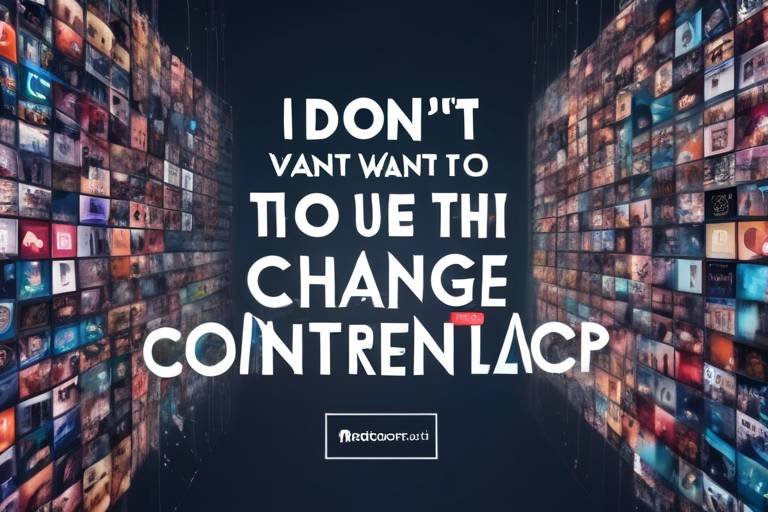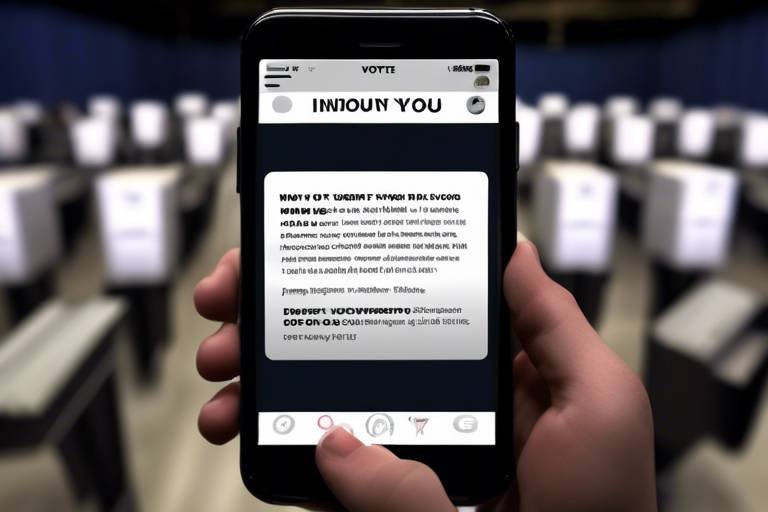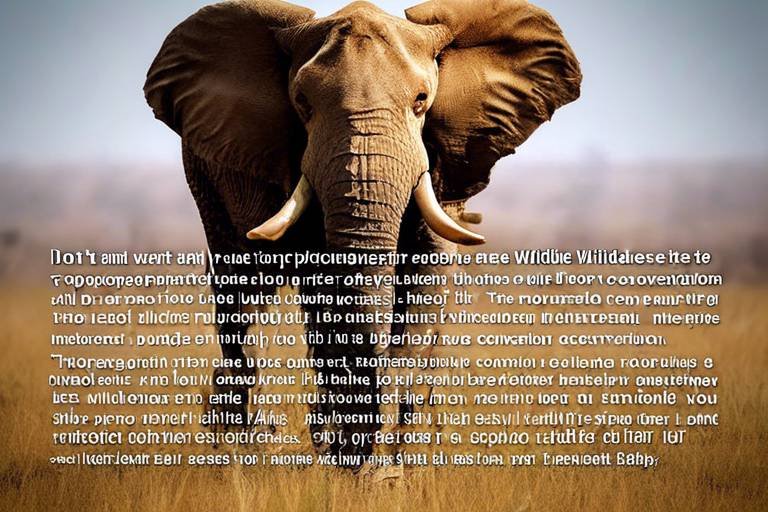How Virtual Reality Will Change Travel Experiences
Imagine stepping into a world where the boundaries of travel are no longer defined by physical limitations. Virtual reality (VR) has emerged as a groundbreaking technology that is set to revolutionize the way we experience travel. Gone are the days when planning a trip meant flipping through glossy brochures or scrolling through endless social media posts. With VR, the entire travel experience can be transformed into an immersive journey that captivates the senses and ignites the imagination.
As we delve into this exciting realm, it's essential to recognize that VR is not just a gadget; it's a portal to new adventures. It enhances our ability to explore destinations, interact with cultures, and even overcome barriers that have traditionally hindered travel. The impact of virtual reality on the travel industry is profound, offering a glimpse into a future where every traveler can embark on their dream journey from the comfort of their home.
In this article, we'll explore how virtual reality is reshaping travel experiences, from pre-trip exploration to immersive cultural encounters. We'll also examine its role in making travel more accessible for everyone, including those with disabilities. So, buckle up as we embark on this virtual adventure that promises to change the way we see the world!
Understanding the historical development of virtual reality technology reveals its potential applications in the travel industry, paving the way for immersive experiences that were previously unimaginable. Initially, VR was primarily associated with gaming and entertainment. However, as technology advanced, its applications began to extend into various sectors, including education, healthcare, and, of course, travel.
Today, we find ourselves at the intersection of technology and wanderlust. The evolution of VR in travel has been nothing short of remarkable, with innovative companies harnessing its power to create experiences that transport users to breathtaking destinations. From virtual reality headsets to interactive 360-degree videos, the tools available to travelers are evolving rapidly, making it easier than ever to explore the world.
Virtual reality allows travelers to explore destinations before visiting, offering a unique preview that influences their travel decisions and enhances overall satisfaction with their chosen locations. Imagine being able to walk through the bustling streets of Tokyo or relax on the sandy beaches of Bali, all without leaving your living room. This ability to preview destinations is a game-changer, as it empowers travelers to make informed choices about where to go and what to do.
Many travel companies now offer virtual tours, allowing potential tourists to experience attractions in 360 degrees. This immersive approach not only helps travelers plan their itineraries more effectively but also provides a taste of what they can expect when they arrive. Whether it’s exploring the ancient ruins of Machu Picchu or taking a stroll through the Louvre, virtual tours make it easier to select activities that align with personal interests.
Virtual tours provide a cost-effective way to explore multiple destinations, helping travelers save time and money while ensuring they choose the best experiences for their trips. Here are some key benefits:
- Cost-Efficiency: No need for expensive flights or accommodations.
- Time-Saving: Quickly explore various options without the need for extensive travel.
- Informed Decisions: Gain a realistic understanding of what to expect at each location.
Despite their benefits, virtual tours can sometimes lack the authentic feel of being physically present, leaving some travelers yearning for real-life experiences. There’s something irreplaceable about the sights, sounds, and smells of a destination that a screen simply cannot replicate. However, as technology continues to improve, the gap between virtual and real experiences is steadily closing.
Virtual reality can immerse users in different cultures, enabling them to experience local customs, traditions, and cuisines without leaving their homes. This not only fosters greater appreciation and understanding but also allows individuals to engage with cultures in a way that was previously inaccessible. Imagine participating in a traditional cooking class in Italy or joining a vibrant festival in India—all through the power of VR!
Virtual reality technology can make travel more accessible for individuals with disabilities, allowing them to experience destinations that might otherwise be challenging to visit in person. This inclusivity is a significant step forward in ensuring that everyone can enjoy the joys of travel, regardless of physical limitations.
Travel companies are increasingly adapting virtual reality experiences to cater to diverse needs, ensuring that everyone can enjoy immersive travel. From wheelchair-accessible virtual tours to sensory-friendly experiences, the industry is making strides to accommodate all travelers. This commitment to inclusivity not only enhances customer satisfaction but also broadens the appeal of travel to a wider audience.
Several travel organizations have successfully integrated virtual reality into their offerings, showcasing the technology's potential to enhance customer engagement and satisfaction. For instance, companies like Thomas Cook and Expedia have launched VR experiences that allow users to explore destinations and book trips seamlessly. These case studies highlight the effectiveness of VR in transforming the travel landscape.
As technology continues to advance, the future of virtual reality in travel looks promising, with potential innovations that could further redefine how we explore the world. Imagine AI-driven virtual travel guides that personalize experiences based on your preferences or even VR experiences that allow you to interact with locals in real-time. The possibilities are endless, and as we embrace this technology, the way we travel will undoubtedly evolve.
- What is virtual reality in travel? Virtual reality in travel refers to the use of VR technology to create immersive experiences that allow users to explore destinations and cultures without physically being there.
- How does virtual reality enhance travel planning? It allows travelers to preview destinations and attractions, helping them make informed decisions about their trips.
- Is virtual reality accessible for people with disabilities? Yes, many travel companies are adapting VR experiences to cater to diverse needs, making travel more inclusive.
- What are the future prospects of virtual reality in travel? The future is bright, with potential innovations like AI-driven guides and real-time interactions with locals set to enhance the travel experience even further.

The Evolution of Virtual Reality in Travel
Understanding the historical development of virtual reality technology reveals its potential applications in the travel industry, paving the way for immersive experiences that were previously unimaginable. From its inception in the mid-20th century, virtual reality has evolved dramatically, transitioning from basic simulations to sophisticated, interactive environments. In the early days, VR was primarily used for military training and aviation simulations, but as technology advanced, it found its way into various fields, including entertainment, education, and, of course, travel.
In the 1990s, the concept of virtual reality began to gain traction with the introduction of VR headsets and interactive environments. However, it wasn't until the 2010s, with the advent of affordable VR technology like the Oculus Rift and HTC Vive, that the travel industry started to take notice. Travel companies began experimenting with virtual tours, allowing potential travelers to preview destinations before booking their trips. This innovation not only enhanced the customer experience but also transformed the way people made travel decisions.
As we delve deeper into the evolution of virtual reality in travel, it's essential to highlight some key milestones:
| Year | Milestone |
|---|---|
| 1960s | First VR headset developed (Sensorama) |
| 1990s | Introduction of commercial VR systems |
| 2012 | Oculus Rift Kickstarter campaign |
| 2016 | Launch of affordable VR headsets (Oculus, HTC) |
| 2020s | Widespread adoption of VR in travel marketing |
Today, virtual reality is not just a novelty; it has become a powerful tool for travel companies. By offering immersive experiences, they can engage potential travelers in ways that traditional marketing methods simply cannot. Imagine being able to stroll through the streets of Paris or relax on a beach in Bali—all from the comfort of your living room. This ability to "try before you buy" has fundamentally changed the travel planning process and has made it easier for travelers to make informed decisions.
Moreover, the integration of augmented reality (AR) into virtual reality experiences is taking things a step further. Travelers can now use their smartphones to overlay digital information onto their surroundings, enhancing their exploration of new destinations. For instance, a traveler could point their phone at a historical site and instantly access a wealth of information about its history, architecture, and significance. This blend of VR and AR is creating a more enriching travel experience that caters to the curious and tech-savvy traveler.
As we look to the future, the evolution of virtual reality in travel is poised to continue its rapid advancement. With ongoing improvements in technology, such as higher resolution displays and more immersive sensory experiences, the possibilities are truly endless. Virtual reality is not just about seeing a destination; it's about feeling it, experiencing it, and connecting with it on a deeper level.

Enhancing Destination Exploration
In today’s fast-paced world, the way we explore destinations has undergone a significant transformation, thanks to the advent of virtual reality (VR). Imagine being able to walk through the bustling streets of Tokyo, gaze at the majestic Eiffel Tower, or even relax on a serene beach in Bali—all from the comfort of your living room! This is the magic of VR, and it's revolutionizing how we plan our travels. With just a headset, travelers can embark on a virtual journey that not only provides a sneak peek into their dream destinations but also helps them make informed decisions about where to go next.
One of the most exciting aspects of VR in travel is the ability to experience virtual tours and experiences. Many travel companies now offer immersive 360-degree tours of popular attractions, allowing potential tourists to explore every nook and cranny of a location before they even set foot there. This technology is not just about seeing; it’s about feeling the essence of a place. For instance, a virtual tour of the Colosseum in Rome can transport you back in time, making you feel like a gladiator preparing for battle, while a stroll through the streets of Venice can make you feel the romance of the canals. The possibilities are endless!
Virtual tours are becoming increasingly popular for travelers looking to maximize their experiences while minimizing costs. These tours allow users to:
- Preview Attractions: Experience famous landmarks and attractions in a way that traditional brochures or websites simply cannot offer.
- Plan Itineraries: Create a well-rounded travel plan by selecting activities that truly resonate with their interests.
- Save Time and Money: Avoid the pitfalls of tourist traps by getting a realistic sense of what to expect.
One of the most significant advantages of virtual tours is their cost-effectiveness. Travelers can explore multiple destinations without the financial burden of travel expenses. Whether it's a weekend getaway or a month-long adventure, virtual tours allow individuals to take their time and choose the best experiences for their trips. Additionally, they can also share these experiences with friends and family, creating a sense of community and shared excitement about future travels.
However, it's essential to acknowledge that virtual tours have their limitations. While they provide a fantastic preview, they can sometimes lack the authentic feel of being physically present in a location. The sights, sounds, and smells of a place can’t be fully replicated through a screen. Some travelers may find themselves yearning for the tactile experiences of real-life exploration, such as tasting local cuisine or engaging with friendly locals. This leaves a lingering question: can virtual reality ever truly replace the thrill of real-world travel?
Beyond just sightseeing, VR offers the chance to dive deep into the cultural fabric of a destination. Imagine participating in a traditional dance in a Balinese village or cooking a local dish with a chef from Tuscany—all without leaving your home! This kind of immersive experience fosters a greater appreciation and understanding of diverse cultures, making travelers more informed and respectful visitors when they finally do make the journey.
In summary, virtual reality is not just a novel technology; it is a game-changer for the travel industry. By enhancing destination exploration, it empowers travelers to make better choices, experience cultures in new ways, and ultimately, enrich their travel adventures. So, the next time you think about planning a trip, consider putting on those VR goggles first. You might just find your next dream destination waiting for you!
Q: Can I experience virtual reality without a headset?
A: While a headset provides the most immersive experience, many virtual tours can also be accessed through a computer or smartphone, though the experience may be less engaging.
Q: Are virtual tours free?
A: Many virtual tours are available for free, but some premium experiences may charge a fee. It's always good to check the offerings of different travel companies.
Q: How do virtual tours help in travel planning?
A: Virtual tours allow travelers to explore various destinations, attractions, and activities, helping them to make informed decisions about their itinerary and what to prioritize during their trip.

Virtual Tours and Experiences
In today's fast-paced world, where time is a precious commodity, virtual tours have emerged as a revolutionary way to experience travel without the need to pack a suitcase or book a flight. Imagine being able to stroll through the bustling streets of Tokyo, admire the intricate architecture of the Eiffel Tower, or even dive into the vibrant underwater world of the Great Barrier Reef—all from the comfort of your living room. This is not just a dream; it's the power of virtual reality (VR) that is changing the way we explore our world.
Many travel companies are now leveraging this technology to offer potential tourists immersive experiences that can help them make informed travel decisions. Virtual tours often utilize 360-degree video technology, allowing users to look around as if they were physically present at the location. These experiences can range from guided museum tours to scenic hikes in national parks, effectively bringing the world to your fingertips. For instance, a virtual tour of the Louvre allows you to admire masterpieces like the Mona Lisa and the Venus de Milo, all while learning about their history and significance through interactive features.
Moreover, virtual tours can significantly enhance the planning process for travelers. By experiencing a destination virtually, individuals can:
- Evaluate different attractions and activities
- Understand the layout of a city or region
- Identify must-see spots and hidden gems
- Save time by narrowing down their itinerary
This capability not only helps in crafting a personalized travel experience but also ensures that travelers can maximize their time and enjoyment once they arrive at their destination. However, while virtual tours provide a glimpse into the beauty and excitement of various locales, they are not without their challenges. Some users may find that these experiences lack the authenticity and emotional connection that comes with being physically present in a place. The sights, sounds, and smells of a destination can never be fully replicated through a screen, leaving some travelers yearning for the real thing.
In summary, virtual tours and experiences are paving the way for a new era of travel planning and exploration. They offer a unique opportunity to preview destinations, allowing travelers to make more informed choices and ultimately enhancing their overall satisfaction. As technology continues to evolve, we can expect even more innovative ways to experience travel virtually, bridging the gap between reality and the digital world.
Q1: What are virtual tours?
Virtual tours are immersive experiences that allow users to explore destinations through 360-degree videos or interactive simulations, providing a glimpse of what to expect when visiting in person.
Q2: How can virtual tours help with travel planning?
Virtual tours assist travelers in evaluating attractions, understanding the layout of a destination, and identifying activities that suit their interests, ultimately leading to better trip planning.
Q3: Are virtual tours as good as real-life experiences?
While virtual tours offer a unique and convenient way to explore, they may lack the emotional and sensory experiences that come with being physically present in a location.
Q4: Can virtual reality make travel more accessible?
Yes, virtual reality can provide experiences for individuals with disabilities or those who may find it challenging to travel, allowing them to explore and appreciate destinations from home.

Benefits of Virtual Tours
Virtual tours are revolutionizing the way we approach travel, offering a plethora of benefits that can enhance both the planning and enjoyment of trips. Imagine being able to stroll through the vibrant streets of Tokyo or admire the stunning architecture of the Eiffel Tower—all from the comfort of your own home. This is just one of the many advantages that virtual tours bring to the table. Not only do they save time and money, but they also provide a unique opportunity to explore various destinations without the commitment of booking a flight or hotel.
One of the most significant benefits of virtual tours is their cost-effectiveness. Traveling can be expensive, with costs piling up from flights, accommodations, and daily expenses. Virtual tours allow potential travelers to experience multiple attractions at a fraction of the cost. For example, instead of spending hundreds on a trip to a distant location, you can enjoy immersive experiences for a small fee, or even for free. This accessibility opens doors for those who may not have the financial means to travel extensively.
Moreover, virtual tours facilitate better decision-making when it comes to travel planning. Travelers can get a real sense of a destination's offerings, helping them to create more tailored itineraries. If you’re considering a trip to Italy, for instance, you can explore the rich history of Rome through a virtual tour, enabling you to prioritize your must-see sites. This not only enhances your overall satisfaction with the trip but also ensures that you make the most of your time once you arrive.
In addition to financial savings and planning advantages, virtual tours also allow for flexibility. You can explore at your own pace, revisiting sections that intrigue you or skipping those that don’t. This personalized approach is particularly beneficial for families or groups with diverse interests. For instance, while one family member may want to delve into the art of the Louvre, another might prefer a virtual stroll through the gardens of Versailles. The ability to cater to different preferences makes virtual tours a fantastic tool for group travel planning.
While the benefits are abundant, it’s essential to recognize that virtual tours are not without their limitations. They can sometimes lack the sensory experiences that come with physical travel—like the smell of fresh pastries in a Parisian café or the sounds of bustling markets. However, the technology is rapidly evolving, and many companies are working to enhance these experiences, bringing us closer to the real thing.
In summary, virtual tours offer a multitude of benefits that can significantly enhance the travel experience. They provide a cost-effective way to explore destinations, aid in planning, and allow for personalized exploration. As technology continues to advance, we can only anticipate further improvements that will make virtual tours even more engaging and realistic.
- What are virtual tours? Virtual tours are online experiences that allow users to explore locations through 360-degree views and interactive elements, mimicking the experience of being there in person.
- How can virtual tours help in travel planning? They provide a preview of destinations, helping travelers decide what attractions to visit and how to structure their itineraries.
- Are virtual tours free? Many virtual tours are available for free, while some may charge a fee for premium experiences.
- Can virtual tours replace real travel? While they offer a great way to explore and plan, they cannot fully replicate the sensory and emotional experiences of actual travel.

Challenges of Virtual Tours
While virtual tours offer a myriad of benefits, they are not without their challenges. One of the primary issues is the lack of authenticity. No matter how advanced the technology becomes, it can be difficult to replicate the true essence of being in a location. For instance, the vibrant sounds of a bustling market or the subtle aroma of local cuisine are elements that virtual reality simply cannot convey. This can lead to a sense of disconnection for some travelers, who may find themselves yearning for the real-life experience.
Another challenge is the technological barrier. Not everyone has access to high-end VR equipment or the internet bandwidth required for seamless streaming. This can create a divide between those who can afford the latest technology and those who cannot, potentially leaving some travelers out of the loop. Additionally, the learning curve associated with VR technology can be daunting for older adults or those who are not tech-savvy, further complicating the situation.
Moreover, virtual tours can sometimes lead to over-saturation of information. With so many options available, travelers may feel overwhelmed when trying to choose which virtual experiences to engage with. This can result in decision fatigue, where the sheer volume of choices detracts from the enjoyment of planning a trip. It's akin to standing in front of a buffet with too many delicious options—sometimes, you just want someone to tell you what to pick!
Lastly, there is the risk of decreased physical travel. As virtual tours become more popular, there is a concern that they might deter people from traveling in person. If individuals feel satisfied with a virtual experience, they may choose to skip the actual trip altogether. This could have significant implications for the travel industry, which thrives on the revenue generated from physical tourism. Striking a balance between virtual exploration and real-world experiences will be crucial for the future of travel.
- What are virtual tours? Virtual tours are online experiences that allow users to explore destinations through 360-degree views, videos, and interactive elements.
- Can virtual tours replace real travel? While they enhance travel planning and provide insights, they cannot fully replicate the sensory experiences of being physically present in a location.
- What technology do I need for a virtual tour? Most virtual tours can be accessed through a standard web browser, though some may require VR headsets for a fully immersive experience.
- Are virtual tours accessible for everyone? Many travel companies are working to make virtual tours more inclusive, but access can still be limited by technology and internet requirements.

Immersive Cultural Experiences
Imagine slipping on a pair of VR goggles and suddenly finding yourself in the bustling streets of Tokyo, surrounded by the aroma of street food and the vibrant sounds of a city that never sleeps. through virtual reality have the incredible ability to transport us to far-off lands, allowing us to engage with local customs, traditions, and cuisines without ever leaving our living rooms. This technology not only satisfies our wanderlust but also deepens our understanding and appreciation of diverse cultures.
One of the most fascinating aspects of virtual reality is its capacity to simulate real-life experiences. For instance, you can participate in a traditional Indian festival, complete with colorful attire, music, and dance, all while sitting comfortably at home. This kind of experience fosters empathy and cultural awareness, bridging the gap between different societies. It’s like having a passport to the world, but without the hefty price tag or the need for a suitcase!
Moreover, virtual reality can be a powerful educational tool. Schools and educational institutions are beginning to harness this technology to enrich their curricula. Students can embark on virtual field trips to ancient civilizations, exploring the ruins of the Roman Empire or walking through the streets of Renaissance Florence. This hands-on approach to learning makes history come alive, transforming textbooks into vibrant, interactive experiences.
Additionally, many cultural institutions, such as museums and art galleries, are embracing virtual reality to enhance visitor engagement. Imagine being able to walk through the Louvre and stand inches away from the Mona Lisa, or exploring the intricate details of a Van Gogh painting in a way that traditional viewing simply cannot offer. These not only attract more visitors but also provide a platform for those who might not have the opportunity to visit these places in person.
However, it’s essential to acknowledge that while virtual reality offers a glimpse into different cultures, it cannot fully replicate the essence of being there in person. The warmth of a local’s smile, the taste of street food, and the feel of the sun on your skin are experiences that VR can only mimic. Yet, it serves as a fantastic starting point, sparking interest and encouraging travelers to explore these cultures more deeply.
In conclusion, the advent of virtual reality is revolutionizing the way we experience culture. It opens doors to understanding and appreciating the world in ways that were once unimaginable. Whether it’s through educational experiences or virtual tours of cultural landmarks, VR is paving the way for a more connected and culturally aware global community.
- What is virtual reality? Virtual reality (VR) is a simulated experience that can be similar to or completely different from the real world. It often involves the use of special equipment like VR headsets.
- How does VR enhance cultural experiences? VR allows users to immerse themselves in different cultures, experiencing local traditions, cuisines, and festivals, which fosters a greater understanding and appreciation of diversity.
- Can VR replace actual travel? While VR offers a unique way to experience cultures, it cannot fully replace the sensory experiences of traveling in person. It serves as a complementary tool to inspire future travel.
- Is VR accessible to everyone? Many companies are working to make VR experiences more inclusive, adapting technology for individuals with disabilities to ensure everyone can enjoy immersive cultural experiences.

Accessibility and Inclusivity in Travel
In today's world, travel should be a right, not a privilege. However, for many individuals with disabilities, the prospect of exploring new destinations can often feel daunting. This is where virtual reality (VR) steps in as a game-changer. By offering immersive experiences that can be accessed from the comfort of one's home, VR technology is breaking down barriers and making travel more accessible than ever before. Imagine being able to explore the stunning ancient ruins of Machu Picchu or the vibrant streets of Tokyo without ever having to leave your living room—this is the magic of virtual reality!
One of the most exciting aspects of VR in travel is its ability to provide experiences tailored to diverse needs. Travel companies are increasingly recognizing the importance of inclusivity and are adapting their offerings accordingly. For instance, virtual reality experiences can be designed to accommodate those with mobility challenges, sensory sensitivities, or other specific requirements. By doing so, they ensure that everyone, regardless of their physical limitations, can enjoy the thrill of travel.
Moreover, VR can serve as a powerful tool for fostering empathy and understanding. When individuals can experience a culture, tradition, or lifestyle through virtual reality, they gain a deeper appreciation for the diversity of our world. This can lead to a more inclusive mindset when it comes to planning real-life travels. For example, a person who has experienced a virtual tour of a local market in Morocco may feel more connected and respectful when they eventually visit in person.
To further illustrate the impact of virtual reality on accessibility in travel, let’s take a look at some real-world examples:
| Organization | Implementation | Impact |
|---|---|---|
| Accessible Travel Solutions | Developed VR experiences for wheelchair users. | Increased bookings by 30% from individuals with mobility challenges. |
| Virtual Tours Inc. | Created sensory-friendly VR environments for individuals with sensory sensitivities. | Enhanced user satisfaction and engagement. |
| Global Tours | Launched a VR platform that offers sign language interpretation for deaf travelers. | Expanded audience reach and improved accessibility. |
As we look to the future, it’s clear that the integration of virtual reality into the travel industry will continue to evolve. With ongoing advancements in technology, the potential for creating even more inclusive and accessible experiences is limitless. Imagine a world where everyone, regardless of their circumstances, can explore far-off lands, immerse themselves in different cultures, and create unforgettable memories—all thanks to the power of virtual reality.
- How does virtual reality enhance accessibility in travel?
Virtual reality allows individuals with disabilities to experience destinations and cultures without the physical limitations that may prevent them from traveling in person. - Are there specific VR experiences designed for people with disabilities?
Yes, many travel companies are creating tailored VR experiences that cater to diverse needs, including mobility challenges and sensory sensitivities. - Can virtual reality replace actual travel?
While virtual reality offers incredible experiences, it is meant to complement, not replace, real-life travel. It provides a unique way to explore and prepare for future trips.

Adapting VR for Diverse Needs
As we dive deeper into the world of virtual reality (VR), it's becoming increasingly clear that this technology isn't just a luxury for the able-bodied; it's a powerful tool for inclusivity. Imagine a world where anyone, regardless of their physical limitations, can experience the wonders of travel. This is the essence of adapting VR for diverse needs. Travel companies are now recognizing the importance of creating experiences that cater to everyone, and they are making significant strides in this direction.
One of the most exciting developments in this area is the customization of VR experiences. For example, companies are incorporating features such as voice commands and haptic feedback, which allow users with mobility impairments to navigate virtual environments with ease. This means that someone who may not be able to physically walk through a museum can still explore its halls, interact with exhibits, and enjoy the art on display—all from the comfort of their home. Isn't that incredible?
Moreover, the integration of various accessibility tools is gaining traction. Many VR platforms now include options for subtitles, audio descriptions, and even sign language interpretation. This ensures that deaf or hard-of-hearing individuals, as well as those with visual impairments, can fully engage with the content. By breaking down these barriers, VR is not just enhancing the travel experience; it’s revolutionizing it.
To illustrate this point, consider the following table showcasing some of the adaptations being made in VR travel experiences:
| Adaptation | Description |
|---|---|
| Voice Navigation | Allows users to control their VR experience using voice commands. |
| Haptic Feedback | Provides tactile responses that simulate touch and movement. |
| Subtitles & Audio Descriptions | Ensures accessibility for the deaf and hard-of-hearing, and aids those with visual impairments. |
| Customizable Environments | Users can adjust settings to suit their needs, such as changing the speed of the experience. |
As more travel companies embrace these adaptations, the potential for VR to create enriching experiences for all travelers becomes more apparent. Imagine being able to walk through the streets of Paris, taste the local cuisine, or join a traditional dance in Bali, all without the physical constraints that might normally hold you back. This not only opens up new avenues for adventure but also fosters a greater sense of empathy and understanding among travelers.
In conclusion, adapting VR for diverse needs is not just a trend; it's a vital evolution in the travel industry. As we continue to innovate and implement these technologies, we pave the way for a future where travel is accessible to everyone. And that's something worth celebrating!
- How does VR help those with disabilities experience travel? VR technology can simulate travel experiences, allowing individuals with mobility or sensory impairments to explore destinations virtually.
- Are there specific VR platforms designed for accessibility? Yes, many VR platforms are now incorporating accessibility features such as voice commands, subtitles, and haptic feedback to cater to diverse needs.
- Can VR replace actual travel? While VR offers incredible experiences, it should be seen as a complement to travel rather than a complete replacement, as nothing can truly replicate the physical sensations and interactions of real-world travel.

Case Studies of Successful Implementation
When it comes to virtual reality in the travel industry, several companies have taken the plunge, showcasing how this technology can transform the way we explore the world. One notable example is Thomas Cook, a travel agency that introduced VR headsets in their stores. Customers can don the headsets to take immersive tours of popular destinations like the beaches of the Maldives or the historic streets of Rome. This not only helps customers visualize their trips but also significantly boosts their excitement and engagement levels, leading to higher booking rates.
Another fascinating case is Marriott Hotels, which launched its Virtual Reality Postcards campaign. By using VR technology, Marriott allows potential guests to experience their hotels and surrounding attractions through immersive video content. Imagine sitting in your living room and being transported to a luxurious suite overlooking the ocean or exploring the vibrant nightlife of a city—all before making a reservation. This innovative approach not only enhances the customer experience but also serves as a powerful marketing tool that captures attention in a crowded marketplace.
Furthermore, Expedia has embraced VR by integrating it into their travel booking platform. They offer virtual tours of hotels and destinations, allowing users to explore accommodations and attractions from the comfort of their own homes. This feature has proven to be particularly beneficial for travelers who may be uncertain about where to stay or what to do during their trips. By providing this immersive experience, Expedia helps users make informed decisions, ultimately leading to a more satisfying travel experience.
These examples illustrate just a few of the ways in which virtual reality is being successfully implemented in the travel industry. The technology not only enhances the customer journey but also serves as a vital tool for businesses to differentiate themselves in a competitive market. As more companies recognize the potential of VR, we can expect to see even more innovative applications that will continue to evolve the way we travel.
- What is virtual reality in travel?
Virtual reality in travel refers to the use of immersive technology that allows users to experience destinations and activities in a simulated environment, enhancing their travel planning and overall experience. - How can virtual reality enhance my travel experience?
It can provide you with a preview of destinations, help you choose accommodations, and allow you to explore cultural experiences without physically being there, making your travel planning more informed and exciting. - Is virtual reality accessible for everyone?
Yes, many travel companies are adapting VR experiences to cater to diverse needs, ensuring that individuals with disabilities can enjoy immersive travel experiences. - What are the challenges of using virtual reality in travel?
While VR offers many benefits, it can sometimes lack the authentic feel of being physically present at a destination, which may leave some travelers wanting more.

The Future of Virtual Reality in Travel
The future of virtual reality (VR) in travel is not just bright; it's practically dazzling! As technology continues to evolve at a breakneck pace, the possibilities for enhancing travel experiences through VR are expanding exponentially. Imagine stepping into a virtual world where you can explore the ancient ruins of Rome or stroll through the vibrant streets of Tokyo from the comfort of your living room. This isn't just a dream—it's the future that VR technology promises to deliver.
One of the most exciting prospects is the potential for hyper-realistic simulations. As VR technology advances, the graphics and sensory feedback will become increasingly lifelike. This means that travelers could experience not just the sights of a destination but also its sounds, smells, and even the feel of the environment. Think about it: you could feel the warm breeze of a Caribbean beach or the chill of a snowy Swiss mountain, all while being miles away. This level of immersion could revolutionize how we choose our travel destinations.
Moreover, the integration of artificial intelligence (AI) with VR is set to enhance personalized travel experiences. Imagine a virtual travel assistant that learns your preferences and curates experiences tailored just for you. This could include suggesting off-the-beaten-path destinations, unique local experiences, or even connecting you with locals for an authentic cultural exchange. The possibilities are endless!
Accessibility is another critical aspect that will shape the future of VR in travel. As VR technology becomes more affordable and user-friendly, it will empower even more people to explore the world virtually. For individuals with disabilities or those who face barriers to physical travel, VR can provide an invaluable opportunity to experience new places and cultures. Travel companies are already beginning to recognize this, and we can expect a surge in VR offerings designed specifically for inclusivity.
In addition, we can anticipate the rise of social VR experiences. Imagine being able to travel with friends or family, even if they’re halfway across the globe. Virtual reality platforms could allow groups to explore destinations together in real-time, sharing reactions and experiences just like they would on a physical trip. This social aspect could create a new wave of travel enthusiasts eager to explore the world together, albeit virtually.
As we look forward to this future, it's essential to consider the ethical implications of such advancements. While VR can enhance travel experiences, it also raises questions about authenticity and the preservation of cultures. How do we ensure that virtual representations of destinations respect and honor the local communities and their traditions? This will be a crucial conversation as we navigate the integration of VR in travel.
In summary, the future of virtual reality in travel is poised to be a game-changer. With advancements in technology, the potential for personalized experiences, increased accessibility, and social interactions, we are on the brink of a travel revolution. The world is becoming more interconnected than ever, and virtual reality is at the forefront of this transformation, making it easier for everyone to explore and appreciate the beauty of our planet.
- What is virtual reality in travel? Virtual reality in travel refers to the use of VR technology to create immersive experiences that allow travelers to explore destinations virtually.
- How can virtual reality enhance my travel experience? VR can provide realistic previews of destinations, help you plan your itinerary, and even allow you to experience local cultures from home.
- Is virtual reality accessible for everyone? Yes, as VR technology becomes more affordable and user-friendly, it is increasingly accessible to a broader audience, including those with disabilities.
- What are the ethical concerns regarding virtual reality in travel? Ethical concerns include ensuring that virtual representations of cultures respect local traditions and do not exploit or misrepresent communities.
Frequently Asked Questions
- What is virtual reality and how does it relate to travel?
Virtual reality (VR) is a technology that creates immersive digital environments, allowing users to experience places and activities as if they were physically there. In travel, VR enhances the way we explore destinations, offering virtual tours and experiences that help travelers make informed decisions before their trips.
- How can virtual reality enhance my travel experience?
VR can significantly enhance your travel experience by providing pre-travel exploration through virtual tours, allowing you to visualize attractions and activities. It can also immerse you in different cultures and environments, giving you a taste of local customs and cuisines, all from the comfort of your home.
- Are virtual tours as good as real-life experiences?
While virtual tours offer a unique and engaging way to explore destinations, they can't fully replicate the authentic feel of being physically present. Some travelers may find that VR lacks the sensory experiences, such as sounds and smells, that come with real-life travel, leaving them longing for the actual experience.
- Can virtual reality make travel more accessible for people with disabilities?
Absolutely! Virtual reality technology can create opportunities for individuals with disabilities to experience travel in ways that may be challenging in real life. By adapting VR experiences to cater to diverse needs, travel companies are ensuring that everyone has the chance to enjoy immersive travel experiences.
- What are some successful examples of virtual reality in the travel industry?
Many travel organizations have successfully integrated VR into their offerings. For instance, some airlines and hotels provide virtual reality experiences to showcase their services, while tourist boards use VR to promote destinations, enhancing customer engagement and satisfaction.
- What does the future hold for virtual reality in travel?
The future of virtual reality in travel is promising, with continuous advancements in technology. Innovations such as improved graphics, haptic feedback, and even augmented reality features could redefine how we explore the world, making travel more immersive and accessible than ever before.



















